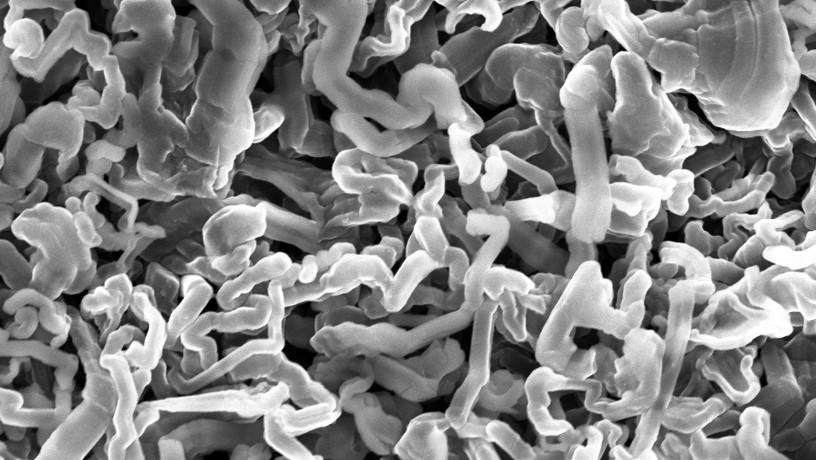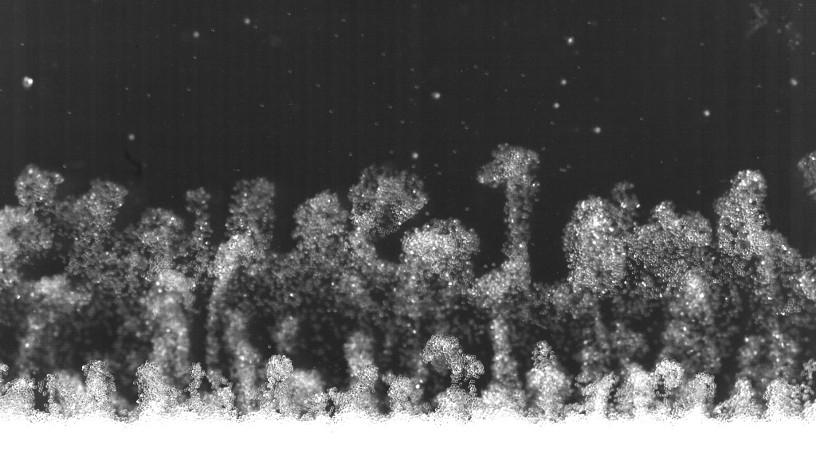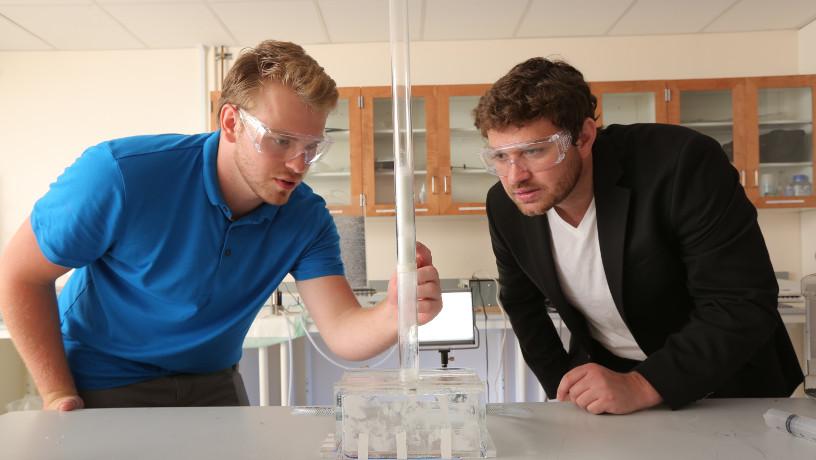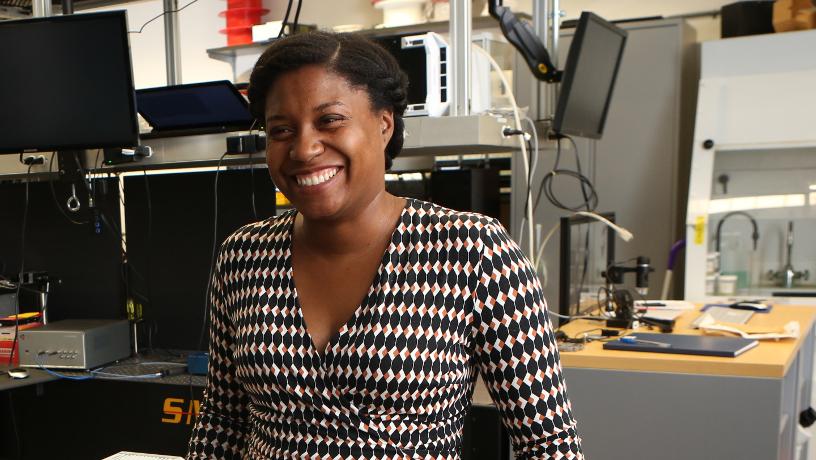Peering Inside The Black Box
Surprisingly little is known about the functioning of many everyday materials. With the help of advanced imaging tools, researchers are beginning to unlock their secrets

Lauren Marbella in her lab.

Scanning electron microscopy image of lithium microstructures deposited on the surface of a lithium metal anode.
It can be surprising to realize just how much remains unknown about the functioning of everyday materials. Using advanced imaging tools and techniques to peer at atoms is allowing Columbia engineers to unlock some of these long-held secrets. Researchers are using these tools in different ways— Lauren Marbella and Christopher Boyce are repurposing MRI techniques honed for medical imaging for industrial/scientific applications, and Christine Hendon is pushing new imaging techniques to understand a biomaterials problem with immediate clinical impact.
To understand how energy storage materials behave under operating conditions, you first have to render the closed system of a battery visible. Assistant Professor of Chemical Engineering Lauren Marbella has found a way to do just that. Using MRI, she can observe how battery materials behave operando with the goal of improving their efficiency, safety, and reliability. Despite their ubiquity and their central role in renewable energy applications, certain aspects of lithium metal batteries remain a mystery. For instance, researchers are working to uncover why sometimes they catch fire and explode and sometimes they don’t; why sometimes the microstructures that build up on the battery’s electrodes build up slowly and dissolve before they cause a short circuit and sometimes they build up fast and progress to thermal runaway.
“Every time we do an experiment, we learn something new,” Marbella says. “Are the microstructures accumulating closer to the electrode surfaces in the battery, or do they approach the separator and cause a short circuit?” To find out, she and her team are loading customized batteries—encased in plastic rather than metal to avoid magnetic interference—into the scanner and watching where, how, and how fast the structures grow as the battery is actively charged and discharged. Similarly, the researchers are working on positioning techniques to minimize distortions caused by the magnetic field on the battery’s interior metal elements.
At the same time, Marbella’s team is uploading the combination of electrochemical and spectroscopic data (which contains chemical information) they cull from nuclear magnetic resonance imaging to a database that machine learning collaborators can mine to help point the way to superior materials. “The data that we’re sharing will help material scientists in several ways. For instance, some of the new compounds we’ve identified challenge previous assumptions about conventional battery structure, while others reveal new strategies for improving that structure going forward,” she says.
Some of the new compounds we’ve identified challenge previous assumptions about conventional battery structure, while others reveal new strategies for improving that structure going forward.

Optical image of “fingers” of sand rising through salt water.

Student Fabio Nierhoff and Chris Boyce (right) investigating flow in particles suspended by gas flow.
For Christopher Boyce, pondering granular flows, including flows as simple and familiar as sand flowing through an hourglass, has led him to discover a new world.
Scientists have long assumed that sand flows in a manner very similar to water, based on observations such as wind-induced sand dune formation in the desert. What Boyce discovered was that while similar aspects of flow can lead to similar features, key physical differences between sand and water sometimes result in flow behavior that is similar in appearance but caused by different underlying mechanisms.
An assistant professor of chemical engineering, Boyce created a methodology to look much deeper than at what the sand appeared to be doing. This methodology combines optical and MRI imaging with computational modeling to quantify motion of granular particles and identify the balance of forces that lead to granular flow behavior. Boyce’s group recently deployed this technique in an experiment investigating whether sand of different densities might behave like oil and water in a lava lamp, in which lighter “fingers” and “bubbles” of oil rise through the heavier medium of water. To his surprise, he found that lighter-weight sand did in fact rise through its heavier counterpart in lava lamp–like structures, despite the fact that different types of sand like to mix, while oil and water do not. Once imaging illuminated this phenomenon, computational modeling allowed Boyce to reveal that completely different force mechanisms underlay the familiar-seeming pattern. He’s now bringing these insights to bear on a collaboration with geoscientists and volcanologists at Columbia’s Lamont-Doherty Earth Observatory who are trying to forecast mud and lava flows. But applications from these findings could eventually touch many aspects of life on Earth.
“We’re beginning to see patterns, and that enables us to control internal flow,” Boyce says. “This work is relevant to understanding not just mud slides and avalanches, but also any number of industrial processes, from energy production, pharmaceuticals, and food production to waste management and treatment.”
Cardiac arrhythmia is a major health issue, sending tens of thousands of older Americans to the emergency room each year. Today, the only treatment for most is a procedure called catheter ablation, where a catheter is threaded into the heart chambers and radiofrequency energy is applied to a tiny patch of muscle—about a fifth of an inch—that’s rhythmically out of sync, to cauterize it. But this procedure, which is performed about 40,000 times annually in the US, has a widely varying success rate of between 50% and 85%. That’s largely because doctors are working somewhat blind: they can guide a catheter on a monitor as it probes heart tissue, but detailed information about the heart tissue and such characteristics as lesion depth is educated guesswork.

Christine Hendon.
High-speed collagen fiber modeling and orientation quantification within optical coherence tomography volumetric images of the heart.
Christine Hendon thought that procedure could be improved. An associate professor of electrical engineering, she has expertise in using advanced biomedical optics technologies to examine fundamental biomaterials architecture and correlate it with function—or dysfunction. By using such tools as near-infrared spectroscopy (NIRS) and optical coherence tomography (OCT) through her imaging experiments to examine heart tissue, “the biggest surprise has been seeing varying levels of fat within the heart muscle,” she says. “We’re exploring how the tissue composition such as healthy muscle, fat, collagen, and scarring affects the electrical signal propagation and the mechanical function.”
Translating her discoveries into a collaboration with cardiac electrophysiologists and pathologists from the University’s Medical Center and other engineers, Hendon is well on the way to developing a real-time guidance, monitoring, and therapeutic probe system based on NIRS and OCT. Through experiments with ex vivo human and pig hearts, Hendon’s team is able to assess how deep the catheter ablation treatment reached, a deeper level of tissue microstructure than was previously possible—down to four millimeters.
But those aren’t the only limitations to current ablation procedures that Hendon is attacking. So far, doctors are unable to visualize the heart’s ventricles with great detail, because the thinner walls of the atrium have been beyond the capability of standard medical imaging tools. The finer resolution possible with Hendon’s OCT technique makes it possible to catalog atrial tissue properties such as fiber architecture, direction, and dispersion and could lead to therapeutic breakthroughs for atrial arrythmia.
Hendon is now creating a cardiac atlas based on analyzing 50 human hearts imaged ex vivo in her lab with OCT; that plus a catalog of donor characteristics she is compiling will result in a database that can be tapped for computer simulations of future experiments.
